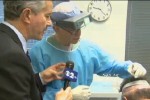Q: I recall that you wrote an article about Monocryl for the donor closure in hair transplants. Why are you now using staples? — R.S., Park Slope, NY
A: I have been using staples in almost all of our follicular unit hair transplants since the beginning of 2006. When we published the Sutures vs. Staples study in 2001, some doctors were still not convinced. Because of this I continued to look at the issue, not in a bilaterally controlled experiment, but just looking at my cases done with the 5-0 Monocryl and those with staples that I continued to use from time to time. After doing hundreds of additional cases, I was still convinced that, overall, the suture line looked better with the 5-0 Monocryl sutures than with the staples.
However, it occurred to me that perhaps we were looking at the wrong thing. I began to think that perhaps we should be looking at hair preservation, rather than cosmesis alone.
The problem with the appearance of stapled closures is that it results in a very well demarcated, geometric line. Monocryl sutures, on the other hand, results in a much softer, more smudgy line – the characteristic that made it look better in the study.
This effect is produced by two things. The first is that the very fine 5-0 Monocryl sutures placed very close to the wound edges allow perfect wound edge approximation. However, the running suture actually destroys some hair as it makes its spiral course through the skin, destroying some hair and producing this smudgy appearance. We had felt that suturing very close to the would edge, using fine suture caliber 5-0 Monocryl, advancing the running stitch on the surface rather than in the SC space, and the mechanism of action of Monocryl absorption (via hydrolysis rather than by an inflammatory reaction) would all mitigate against any hair loss – but there was still some. It seemed that although the overall look was better with sutures, it might be at the expense of some hair loss.
To test this, I began to look at the hair yields in the donor strips of second hair transplant procedures where the new harvest completely encompassed the old scar. It seemed, at least anecdotally, that the strip containing an old incision that had been sutured closed contained slightly less hair than that from one that was stapled closed, even if the former looked better. Although I did not do a rigorous study, this was my “sense.”
In addition, I realized that staples could be left in the scalp for 3 weeks after a hair transplant without causing excessive inflammation (patient discomfort not withstanding) and this gave me more flexibility in using staples in patients with slightly tight scalps without having to rely on subcutaneous sutures. I began to take out alternate staples at 7 to 10 days and the remaining staples at 18-21 days post-op.
With the issue of hair preservation, rather than just the cosmetic benefit, as the main goal and with the added flexibility of being able to leave in alternate staples for up to 3 weeks, I started using staples routinely in almost all of our hair transplants.
Posted by Robert M. Bernstein M.D. 

 Dr. Bernstein was featured in a CBS News report on
Dr. Bernstein was featured in a CBS News report on 



